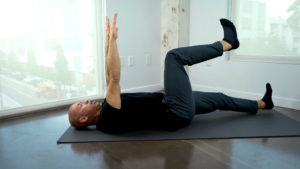Dead Bug Exercise For Back Pain
Back pain is a common affliction that affects millions of people worldwide. Whether caused by poor posture, a sedentary lifestyle, or an injury, finding effective ways to alleviate back pain is crucial for maintaining a healthy and active life. One exercise that has garnered attention for its benefits in strengthening the core and relieving back pain is the “Dead Bug” exercise.
In this blog, we’ll delve into what the Dead Bug exercise is, its benefits, and address some frequently asked questions to help you incorporate it into your fitness routine.
What is the Dead Bug Exercise?
Table of Contents
ToggleThe Dead Bug exercise is a core stabilization move that involves lying on your back and extending your limbs in a controlled manner. It’s named for the way your body resembles a dead bug lying on its back, legs and arms flailing in the air.
Despite its seemingly simple appearance, it is highly effective in strengthening the core muscles and improving overall stability.
How to Perform the Dead Bug Exercise
- Starting Position: Lie on your back on a mat or a comfortable surface. Raise your legs so your hips and knees are both bent at 90 degrees. Your arms should be extended straight up toward the ceiling.
- Engage Your Core: Tighten your abdominal muscles to flatten your lower back against the floor. This engagement helps protect your spine and ensures you’re using your core muscles effectively.
- Movement: Slowly lower your right arm and left leg toward the floor, keeping both limbs straight. Ensure your lower back remains pressed into the mat throughout the movement.
- Return to Start: Bring your arm and leg back to the starting position and repeat the movement with your left arm and right leg.
- Repetitions: Perform the exercise for 10-15 repetitions on each side, or as recommended by your fitness professional.
Benefits of the Dead Bug Exercise
1. Core Strengthening
The Dead Bug exercise primarily targets the core muscles, including the rectus abdominis, obliques, and transverse abdominis. A strong core is essential for stabilizing the spine and pelvis, which can help prevent and alleviate back pain.
2. Improved Stability
By focusing on controlled movements and maintaining proper form, the Dead Bug exercise enhances overall body stability. This increased stability can improve balance and coordination, which is beneficial for preventing falls and injuries.
3. Reduced Lower Back Pain
Engaging the core muscles helps support the lower back and reduces the strain on the spine. Regularly performing the Dead Bug exercise can strengthen the muscles that support the lower back, potentially reducing chronic pain.
4. Better Posture
A strong core contributes to better posture by helping you maintain a neutral spine position. Improved posture can alleviate the pressure on the lower back and reduce discomfort.
5. Low Impact
The Dead Bug exercise is gentle on the joints and doesn’t involve high-impact movements. This makes it suitable for individuals with varying fitness levels and those recovering from injuries.
Conclusion
The Dead Bug exercise is a valuable addition to any fitness routine, particularly for those dealing with back pain. By strengthening the core and improving stability, this simple yet effective exercise can help alleviate discomfort and support overall spinal health. As with any exercise, proper form and consistency are key to achieving the best results.
If you have specific health concerns or conditions, consult with a healthcare professional to ensure the Dead Bug exercise is appropriate for your needs. Incorporate it into your routine and experience the benefits of a stronger, more stable core.
Moreover, you can seek assistance from Mark Lauren and watch the tutorial videos for better understanding.
FAQs About the Dead Bug Exercise for Back Pain
1. Is the Dead Bug Exercise Safe for Everyone?
While the Dead Bug exercise is generally safe for most people, it’s important to listen to your body and consult with a healthcare professional if you have existing health conditions or recent injuries. If you experience any pain or discomfort while performing the exercise, stop immediately and seek advice.
2. How Often Should I Do the Dead Bug Exercise?
For optimal results, aim to incorporate the Dead Bug exercise into your routine 2-3 times per week. Consistency is key to building core strength and experiencing the benefits. However, it’s important to balance this exercise with others that target different muscle groups and aspects of fitness.
3. Can I Do the Dead Bug Exercise If I Have a Herniated Disc?
If you have a herniated disc, it’s crucial to approach any exercise with caution. The Dead Bug exercise can be beneficial, but it should be done under the guidance of a healthcare provider or physical therapist. They can help modify the exercise or suggest alternative movements that are safer for your condition.
4. What Common Mistakes Should I Avoid?
Common mistakes to avoid include:
- Arching the Lower Back: Ensure your lower back remains pressed against the floor to prevent unnecessary strain on your spine.
- Moving Too Quickly: Perform the exercise in a slow and controlled manner to maximize effectiveness and minimize the risk of injury.
- Not Engaging the Core: Keep your abdominal muscles engaged throughout the movement to protect your lower back and support proper form.
5. Can I Use Weights or Add Variations to the Dead Bug Exercise?
Once you’ve mastered the basic Dead Bug exercise and built sufficient core strength, you can incorporate variations or use light weights to increase the challenge. Some variations include:
- Holding Weights: Use light dumbbells or a resistance band to add resistance.
- Dead Bug with a Stability Ball: Place a stability ball between your hands and knees to increase the difficulty.
- Toe Taps: Instead of extending your leg fully, tap your toes on the floor while keeping your knee bent.
Always ensure you maintain proper form when adding variations or weights to avoid injury.
6. How Long Will It Take to See Results?
Results can vary depending on your current fitness level and consistency. Many people notice improvements in core strength and stability within a few weeks of regular practice. For noticeable changes in back pain, it may take several weeks to a few months of consistent effort. Pairing the Dead Bug exercise with other core-strengthening and flexibility exercises can enhance results.
7. Can I Perform the Dead Bug Exercise During Pregnancy?
Pregnant individuals should consult with their healthcare provider before starting any new exercise routine. In many cases, the Dead Bug exercise can be adapted for pregnancy, but it’s important to ensure that it is done safely and in a manner that does not put undue strain on the body.



